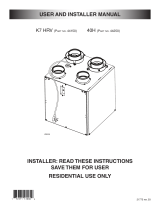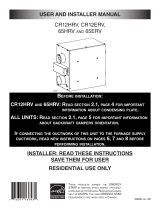
12
4. CONTROLS
4.1 INTEGRATED CONTROL
All units are equipped with an integrated control, located under the unit, in front of the
electrical compartment. Use the push button (1) to control the unit. The LED (2) will then
shows on which mode the unit is in. Refer to table below.
WARNING
Risk of electric shock. Before performing
any maintenance or servicing, always
disconnect the unit from its power source.
AVERTISSEMENT
Danger d’électrocution. Débranchez
toujours l’appareil avant d’entreprendre
des travaux d’entretien ou de réparation.
CAUTION
Unscrew both screws to open the electrical
compartment. To completely remove, detach
from its retention wire inside.
ATTENTION
Dévisser les deux vis pour ouvrir le compartiment
électrique. Pour retirer complètement, le
détacher de son fil de rétention intérieur.
No li gh t OFF or remote controled
Amber light LOW speed
Green ligh HIGH speed
Blinking light See User Manual
Sans lumière Arrêté ou contrôlé
par contrôle mural
Lumière ambre Basse vitesse
Lumière verte Haute vitesse
Clignotant Voir guide d’utilisation
VD0182
12
LED COLOR RESULTS
AMBER UNIT IS ON LOW SPEED
GREEN UNIT IS ON HIGH SPEED
NO LIGHT UNIT IS OFF OR CONTROLLED BY A MAIN CONTROL
If a problem occurs during the unit operation, its integrated control LED (2) will blink. The color of the blinking light depends on the type of
error detected. Refer to Section 8B, TROUBLESHOOTING on page 21 for further details.
4.1.1 B
OOT SEQUENCE
The unit boot sequence is similar to a personal computer boot sequence. Each time the unit is plugged after being unplugged, or
after a power failure, the unit will perform a 30-second booting sequence before starting to operate. During the booting sequence,
the integrated control LED will light GREEN or AMBER for 5 seconds, and then will shut off for 2 seconds. After that, the LED will
light RED for the rest of the booting sequence. During this RED light phase, the unit is checking and resetting the motorized damper
position. Once the motorized damper position completely set, the RED light turns off and the booting sequence is done.
NOTE: No command will be taken until the unit is fully booted.
4.2 ELECTRICAL CONNECTION TO OPTIONAL WALL CONTROLS
For more convenience, this unit can also be controlled using an optional main wall control.
NOTES: 1. The integrated control must be turned OFF to use an optional main control.
2. If an optional auxiliary control is used, if activated, this auxiliary control will override the optional main control.
WARNING
Always disconnect the unit before making any connections. Failure in disconnecting power could result in electric shock or
damage of the wall control or electronic module inside the unit.
!
CAUTION
Never install more than one optional main wall control per unit. Make sure that the wires do not short-circuit between
themselves or by touching any other components on the wall control. Avoid poor wiring connections. To reduce electrical
interference (noise) potential, do not run wall control wiring next to control contactors or near light dimming circuits, electrical
motors, dwelling/building power or lighting wiring, or power distribution panel.
Use the terminal connector included in the installation kit to perform the electrical
connection for main and optional wall controls. Check if all wires are correctly inserted in
their corresponding holes in the terminal block. (A wire is correctly inserted when its orange
receptacle is lower than another one without wire. On illustration at right, wire A is correctly
inserted, but not wire B.)
Splice back the end of the cable to access the 4 wires. Strip the end of each wire. Connect
each wire to its corresponding terminal: YELLOW wire to “Y’’, RED wire to “R’’, GREEN wire
to “G’’ and BLACK wire to “B’’. Check if all wires are correctly inserted in their corresponding
holes in the terminal block.
Connect the auxiliary control cable, if installed (not shown).
VE0272
A
B
4.1. 2 S
ETTING EXTENDED DEFROST
These units are factory set to normal defrost. In cold region (outdoor temperature -17°F and lower), it may be necessary to setup
extended defrost. During the first 2 seconds of booting sequence, while the integrated control LED is GREEN, press on push
button for 3 seconds to set the unit in extended defrost; the LED will blink AMBER to show the unit is in extended defrost mode.
After that, the LED will shut off, then light RED (the unit returns in its booting sequence).

























